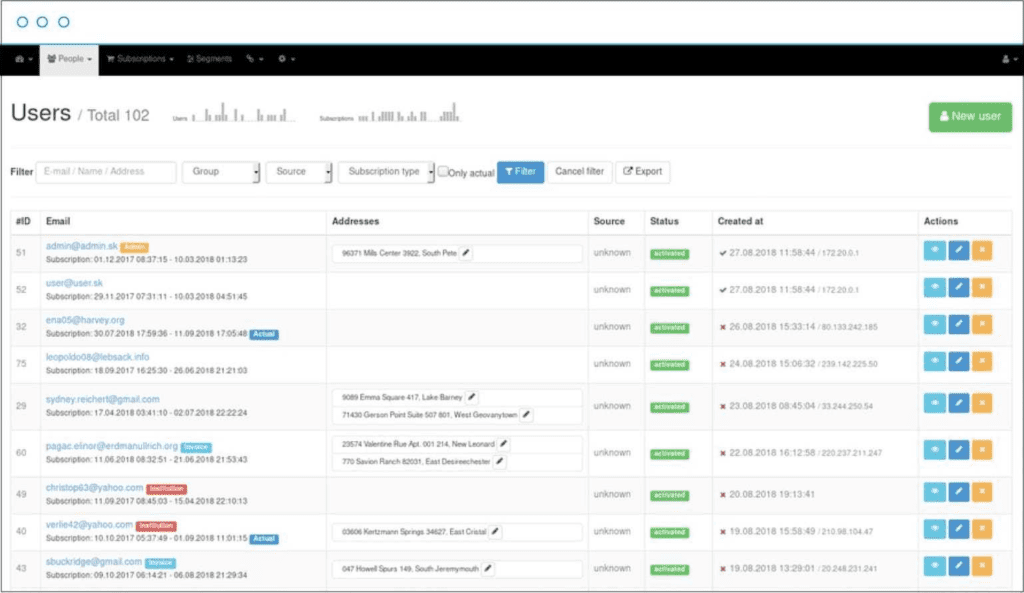|
Getting your Trinity Audio player ready...
|
Slovakian news publisher Denník N expects a profit of €1M for 2020-2021, reports WAN-IFRA. That’s remarkable considering it was founded in 2014 by a group of journalists after the newspaper they worked for was bought by an oligarch.
The publisher has expanded to 100 employees, after launching with 50 journalists. It has 65,000 active subscribers who pay between €5 and €9 for its tiered subscription. And 1.5M unique readers—nearly a third of the country’s population—visiting its website every month.

“Our best shot was asking people to subscribe to our product”
The publisher focused on paid subscriptions right off the bat since it did not expect to benefit from ad revenue.
“When we launched, we knew we would face problems in getting advertisement money because of the oligarch influence,” said Tomas Bella, Dennik N’s Head of Digital at WAN-IFRA’s recent Digital Media Europe conference.
We figured that our best shot was asking people to subscribe to our product. So, we still print a newspaper, but our whole business is based on subscriptions, where 95% of those are online subscriptions.
Tomas Bella, Head of Digital, Dennik N
Being reader-funded, the editorial team has always focused on producing journalism that drives subscriptions. They have tried a number of tools over the years, including Chartbeat and Google Analytics, to understand how articles drive subscriptions.
“Focus on metrics that matter”
However, these tools were not suitable as they drove the team to focus on the wrong metrics. “We learnt that we have to be digital-first and focus on journalism that matters (not average 500-words stories every news site has),” says Filip Struhárik, Reporter and Editor, Denník N. “So we focus on metrics that matter, not clicks.” The team then built a set of tools on its own to understand readers’ better.
It’s an open source software and subscription platform called REMP (Readers’ Engagement and Monetisation Platform). It helps journalists understand what readers consider quality content and are likely to pay for. REMP can also predict churn rate which helps the publisher customise discounts and subscription rates for each user segment.
We needed to understand the behaviour of people on the website and target them with marketing in a sophisticated way.
Tomas Bella, Head of Digital, Dennik N
The platform provides journalists with real-time data on how well their stories have been converting readers into subscribers. They also receive a daily email with top converting emails of the previous day. These are discussed in the daily editorial meeting and inform future content. However, this does not mean that the publisher focuses only on stories that drive subscriptions. Important stories continue to be covered.

“Strong correlation” between editorial judgment and readers’ requirements
“We were thinking there would be this big clash between the business side and editorial side,” says Bella. “But we are finding there is a very strong correlation between what we think is the highest quality of journalism and what readers actually think is the best.”
He says that journalists are not directed to write more on the topics that bring subscribers. They get access to audience insights via REMP and are free to decide the extent to which the data will inform their work. In fact, managers are careful not to provide journalists with too much analytics. This is particularly true for stats like page view numbers that might damage the quality of their reporting.
For many years, we lived in a world where the business department was happy if the page views numbers were very high. This led people to produce clickbait. Authors and editors shouldn’t care about these numbers because it’s not relevant for their work.
Tomas Bella, Head of Digital, Dennik N
When there is a story that has a lot of visitors but isn’t creating enough subscribers, it is analyzed and modified to improve conversion. For example, the heading, introduction, or the number of words visible before the paywall message may be modified. REMP also allows A/B testing of headings to assess which ones are better at converting readers to subscriptions.
“People are not willing to pay for things they can read elsewhere”
Denník N uses a freemium paywall model. It has a mix of long form articles on politics and investigative reporting, and breaking news stories. The long form content is behind paywall and breaking news stories are free. “Short news brings a lot of traffic, and long articles bring a lot of revenue,” comments Bella.
REMP has allowed the publisher to put more articles behind paywall, and prioritize longer form content. Over the years, it has reduced the number of free articles, as well as the number of stories it publishes. It has doubled down on both paid articles and long-form journalism. In 2015, 37% of the digital articles were paid. By 2018, 74% of the articles were behind paywall.

“Our main focus is on longer stories. A lot of original added value has been our strategy from the beginning. People are not willing to pay for things they can read elsewhere,” Lukáš Fila, Director at N Press, the publisher of Denník N, told NiemanLab in an earlier interview. In-depth articles attract the most subscribers; domestic politics and economic stories being key strengths.
Building a “virtuous cycle”
“Getting to the point at which they can so strongly monetize content is no mean feat,” says Tim Gosling, Contributor, International Press Institute. “The entire media world has been trying to work that one out for years.” Building a great and sizable team has been an important component in their success, according to Fila.
“We were told in Slovakia when we started that we had too many people,” Fila told Gosling, “but without enough content you won’t get the readers.”
“You know how some publishers were caught in a vicious circle of “revenues falling –> let’s cut some journalism jobs –> now the revenues are falling faster because there is less quality stuff to read,” Bella wrote in his announcement of the company’s annual results in 2020.
Denník N is now caught in this opposite, virtuous cycle: for past 3 years, as soon as our revenues grew, we spent it on new projects, always tried to hire more great journalists (we doubled the newsroom size in last 2 years) and software developers, always launching new products as soon as we could afford them. And the revenues kept growing.
Tomas Bella, Head of Digital, Dennik N
“An independence which is unique”
The focus on reader revenue has also allowed the publisher to operate independently of business or political pressure. In fact, the N in its name stands for Nezavislost, or independence, while Denník means daily newspaper.
“We don’t count on advertisements or money from print, giving us an independence which is unique,” Matúš Kostolný, Denník N’s Editor-in-chief told NiemanLab.
The publisher has benefitted from the ‘corona bump’. At the height of the lockdown, it saw strong growth in both traffic and subscriptions. While that came down to normal levels after restrictions were lifted, those who signed up during the crisis have stayed, says Ján Simkanič, Publisher, Dennik N.
Although he cannot comment on the longer-term effects, Simkanič is optimistic. “If the economy falls then everyone is vulnerable,” he adds, “but because we rely on subscriptions rather than ads, we’re better prepared than many of the big media houses.”



